Resident Crews of the Mir
![]()
Mir: Expedition 10 |
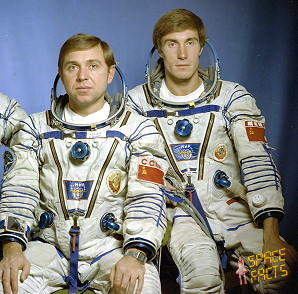 |
|
![]()
Crew, launch- and landing data
| No. | Nation | Surname | Given names | Position | Spacecraft (launch) |
Launch date |
Launch time |
Spacecraft (landing) |
Landing date |
Landing time |
Mission duration |
Orbits |
| 1 | Volkov | Aleksandr Aleksandrovich | Commander | Soyuz TM-13 | 02.10.1991 | 05:59:38.035 UTC | Soyuz TM-13 | 25.03.1992 | 08:51:02 UTC | 175d 02h 51m 24s | 2771 | |
| 2 | Krikalyov | Sergei Konstantinovich | Flight Engineer | Soyuz TM-12 | 18.05.1991 | 12:50:27.919 UTC | Soyuz TM-13 | 25.03.1992 | 08:51:02 UTC | 311d 20h 00m 34s | 4934 |
Backup Crew
| No. | Nation | Surname | Given names | Position |
| 1 | Viktorenko | Aleksandr Stepanovich | Commander | |
| 2 | Kaleri | Aleksandr Yuriyevich | Flight Engineer |
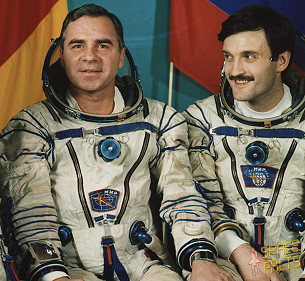 |
Expedition Report
|
Launch from the Baikonur Cosmodrome and
landing 85 km northeast of Arkalyk. Following a two-day solo flight Soyuz TM-13 docked with the Soyuz TM-12-Kvant1-Mir-Kvant2-Kristall space station on October 04, 1991. Soyuz TM-13 carried Austrian Research Cosmonaut Franz Viehböck and Kazakh Research Cosmonaut Toktar Aubakirov. The flight was unusual for carrying no Flight Engineer. Veteran Russian cosmonaut Aleksandr Volkov commanded. The Austrians paid $7 million to fly Franz Viehböck to Mir, and the Kazakh cosmonaut flew partly in an effort to encourage newly-independent Kazakhstan to continue to permit launchings from Baikonur Cosmodrome. The Research Cosmonauts photographed their respective countries from orbit and conducted the usual range of materials processing and medical experiments. Anatoli Artsebarsky traded places with Aleksandr Volkov and returned to Earth in Soyuz TM-12. Sergei Krikalyov remained aboard Mir on his unplanned long-duration mission together with Aleksandr Volkov to make up the Mir-10 crew. Franz Viehböck became the first Austrian in space. As part of the AUSTROMIR 91 program the crew performed scientific experiments with the ninth resident crew. The considerable Austrian research program was completed. In order to do this, many pieces of equipment had been brought to Mir before. The research program comprised medical tests as the regulation of blood pressure und and blood circuit, circulation of bloodstreams in zero gravity (pulse transfer experiment). The researchers used a specially developed sensor jacket (noninvasive) to find out what the influence of zero gravity on micro-vibrations on the arm was. They also wanted to find out more about the muscles of arms and legs. This knowledge should increase the knowledge about the functions of the human body in general but were not focused on cosmic application. There were also the experiments Audimir - research on orientation by sounds - and research about the composition of blood and the function of the lungs. Much attention found also the physical experiment LOGION, with which the operability was studied by liquid metal ioneemitter on space conditions. Such ioneemitter is to prevent flashovers, which had led so far frequently to losses in the power supply of spacecraft. The ESA as well as the NASA are very interested in newly developed technical innovations (mass spectrometers, on-board computer, ion microscope). Further experiments within the range of the program AustoMir concern the remote sensing with a special camera a multi-channel spectrometer (Reflective properties of different soil and vegetation surfaces), data collection, storage and transmission of a special communication unit (Datamir), as well as video conferencing, and amateur radio contact with schools in Austria and the Soviet Union. Some of the experiments were continued by the resident crew (Aleksandr Volkov, Sergei Krikalyov). Main task of the flight was a partial exchange of the Mir resident crew. Aleksandr Volkov and Sergei Krikalyov became the tenth MIR resident crew. By this time, Aleksandr Volkov observed, the Mir base block had suffered orbital debris and meteoroid damage on the flat sealing surface of one of its docking rings and on most of its windows. Progress M-10 broke off its first docking attempt on October 19, 1991 at a distance of 150 m. It successfully docked on October 21, 1991. In October 1991 the cosmonauts extended a Diagramma boom from Mir's small airlock to test the atmosphere around the station. Mir problems were observed. The cosmonauts ended 1991 by replacing storage batteries and conducting ongoing repairs on the complex. At the end of the year total solar array power production was down to 10 kW. In addition, 4 of 6 gyrodynes on Kvant2 and 1 of 6 gyrodynes on Kvant (5 of Mir's total of 12) had failed. Progress M-10 topped off Mir's propellant tanks on January 13, 1992. Undocking planned for January 18, 1992 was postponed by a problem with the wiring of Mir's gyrodynes, which affected the station's attitude. When it undocked on January 20, 1992, it carried a Raduga return capsule, which was safely recovered. On January 27, 1992 Progress M-11 arrived. The spacecraft carried a repair kit for the station's gyrodynes. During its approach to the station, flight controllers in the TsUP were on strike for higher rates of pay, but they did not interfere with the docking. Progress M-11 boosted the complex into a 413 km by 380 km orbit before undocking. In January 1992 the fleet of ocean-going tracking ships in place since the early 1960s was phased out of Mir operations to save funds. Some of the ships continued to operate to support unmanned missions, and could step in as a backup when needed to support Mir. By mid-February 1992, Mir was spending up to 9 hours each day out of touch with the TsUP because of tracking system cutbacks. The only EVA during this mission was undertaken on February 20, 1992 (4h 12m) by Aleksandr Volkov and Sergei Krikalyov. The heat exchanger on Aleksandr Volkov's Orlan-DMA spacesuit failed, forcing a hasty revision of the EVA plans. Aleksandr Volkov remained near the hatch, so could not operate the Strela boom to move Sergei Krikalyov to the prime work site on Kvant. Aleksandr Volkov assisted in installation of space exposure experiments near the hatch, then Sergei Krikalyov clambered down Kvant2 and over the hull to Kvant. He disassembled equipment used in building the Sofora girder in July 1991, then cleaned the cameras on Kvant. Finally, he collected samples of solar cells added to the third (top) array on the base block in 1988. Russian sources stated later that the malfunction occurred because the suit was stored for several months. Later, the two long term cosmonauts dedicated materials science, biological and astronomical studies (studies of X-ray sources, such as Cygnus X-1 and SN Cassiopeia A). So, high-purity single crystals were produced with the smelting plant of SPLAV. Also, high-purity, biologically active substances were won with the help of the system of TAVRIYA which are to be used in the production of drugs, as well as in the food industry and genetic research. A semi-industrial plant for breeding new animal antibiotics (experiment ROBOT) has been successfully tested. Soyuz TM-14 arrived on March 19. 1992. Aboard was the Mir-11 crew, Aleksandr Viktorenko and Aleksandr Kaleri, and Klaus-Dietrich Flade, who became the second German to visit a space station. The first was Sigmund Jähn of East Germany (GDR), who visited Salyut 6 in 1978. During his six days aboard Mir, Klaus-Dietrich Flade conducted 14 German experiments as part of Germany's preparation for participation in the Freedom and Columbus space station projects. Sergei Krikalyov was to have returned to Earth in October 1991, but moves to cut costs had forced modifications to his mission. A Soyuz-TM flight was cancelled, and his replacement, Aleksandr Kaleri, was bumped from the Soyuz TM-13 flight to make way for Toktar Aubakirov on the Soyuz TM-13 flight. Sergei Krikalyov had to remain on board Mir. Western news agencies had reported that Sergei Krikalyov was stranded on Mir, though this was of course incorrect. The Soyuz spacecraft is composed of three elements attached end-to-end - the Orbital Module, the Descent Module and the Instrumentation/Propulsion Module. The crew occupied the central element, the Descent Module. The other two modules are jettisoned prior to re-entry. They burn up in the atmosphere, so only the Descent Module returned to Earth. Having shed two-thirds of its mass, the Soyuz reached Entry Interface - a point 400,000 feet (121.9 kilometers) above the Earth, where friction due to the thickening atmosphere began to heat its outer surfaces. With only 23 minutes left before it lands on the grassy plains of central Asia, attention in the module turned to slowing its rate of descent. Eight minutes later, the spacecraft was streaking through the sky at a rate of 755 feet (230 meters) per second. Before it touched down, its speed slowed to only 5 feet (1.5 meter) per second, and it lands at an even lower speed than that. Several onboard features ensure that the vehicle and crew land safely and in relative comfort. Four parachutes, deployed 15 minutes before landing, dramatically slowed the vehicle's rate of descent. Two pilot parachutes were the first to be released, and a drogue chute attached to the second one followed immediately after. The drogue, measuring 24 square meters (258 square feet) in area, slowed the rate of descent from 755 feet (230 meters) per second to 262 feet (80 meters) per second. The main parachute was the last to emerge. It is the largest chute, with a surface area of 10,764 square feet (1,000 square meters). Its harnesses shifted the vehicle's attitude to a 30-degree angle relative to the ground, dissipating heat, and then shifted it again to a straight vertical descent prior to landing. The main chute slowed the Soyuz to a descent rate of only 24 feet (7.3 meters) per second, which is still too fast for a comfortable landing. One second before touchdown, two sets of three small engines on the bottom of the vehicle fired, slowing the vehicle to soften the landing. Sergei Krikalyov, together with Klaus-Dietrich Flade and Aleksandr Volkov, undocked from Mir aboard Soyuz TM-13 on March 25, 1992. They landed uneventfully, although NPO Energiya had to pay Kazakh authorities $15,000 in rents for airports and helicopters during the recovery operation. |
EVA data
| Name | Start | End | Duration | Mission | Airlock | Suit | |
| EVA | Krikalyov, Sergei | 20.02.1992, 20:09 UTC | 21.02.1992, 00:21 UTC | 4h 12m | Soyuz TM-13 | Mir - Kvant2 | Orlan-DMA No. 8 |
| EVA | Volkov, Aleksandr | 20.02.1992, 20:09 UTC | 21.02.1992, 00:21 UTC | 4h 12m | Soyuz TM-13 | Mir - Kvant2 | Orlan-DMA No. 12 |
Relocations of Manned Spacecrafts
| Spacecraft | from | Undocking | Time UTC | to | Redocking | Time UTC |
| Soyuz TM-13 | Mir - Baseblock | 15.10.1991 | 01:00:25 | Mir - Kvant | 15.10.1991 | 02:45:08 |
| Soyuz TM-13 | Mir - Kvant | 14.03.1992 | 11:43 | Mir - Baseblock | 14.03.1992 | 12:10 |
Photos / Graphics
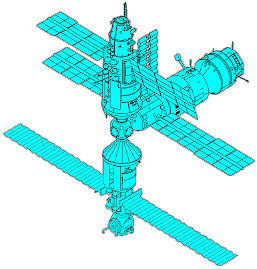 |
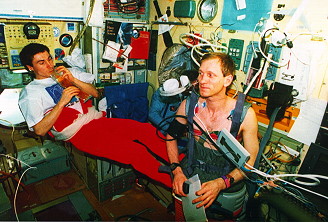 |
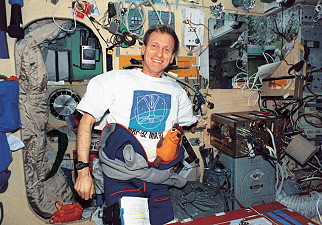 |
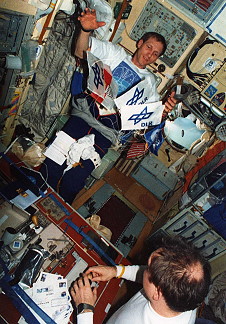 |
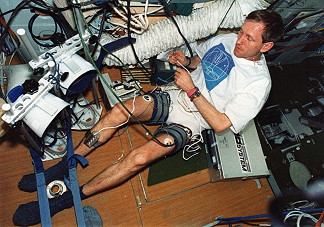 |
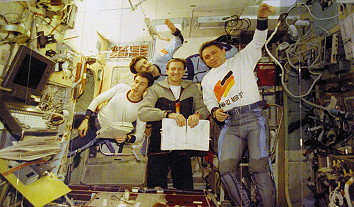 |
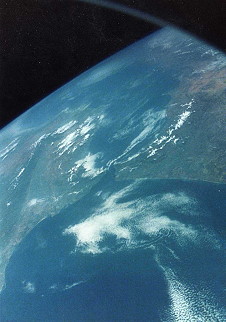 |
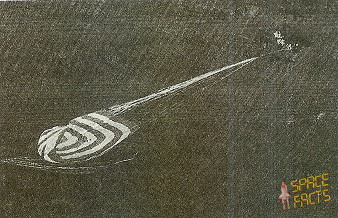 |
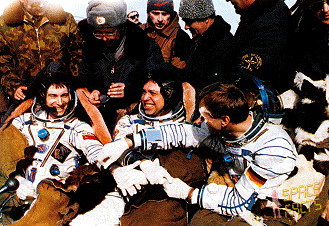 |
| © |  |
Last update on March 31, 2025.  |
 |